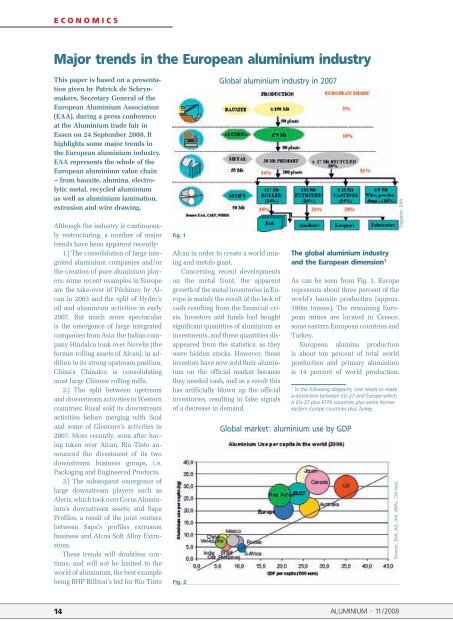SPecIAL - Alu-web.de
SPecIAL - Alu-web.de
SPecIAL - Alu-web.de
You also want an ePaper? Increase the reach of your titles
YUMPU automatically turns print PDFs into web optimized ePapers that Google loves.
E c o n o M i c s<br />
Major trends in the European aluminium industry<br />
This paper is based on a presentation<br />
given by Patrick <strong>de</strong> Schrynmakers,<br />
Secretary General of the<br />
European <strong>Alu</strong>minium Association<br />
(EAA), during a press conference<br />
at the <strong>Alu</strong>minium tra<strong>de</strong> fair in<br />
Essen on 24 September 2008. It<br />
highlights some major trends in<br />
the European aluminium industry.<br />
EAA represents the whole of the<br />
European aluminium value chain<br />
– from bauxite, alumina, electrolytic<br />
metal, recycled aluminium<br />
as well as aluminium lamination,<br />
extrusion and wire drawing.<br />
Although the industry is continuously<br />
restructuring, a number of major<br />
trends have been apparent recently:<br />
1.) The consolidation of large integrated<br />
aluminium companies and/or<br />
the creation of pure aluminium players:<br />
some recent examples in Europe<br />
are the takeover of Péchiney by Alcan<br />
in 2003 and the split of Hydro’s<br />
oil and aluminium activities in early<br />
2007. But much more spectacular<br />
is the emergence of large integrated<br />
companies from Asia: the Indian company<br />
Hindalco took over Novelis (the<br />
former rolling assets of Alcan); in addition<br />
to its strong upstream position,<br />
China’s Chinalco is consolidating<br />
most large Chinese rolling mills.<br />
2.) The split between upstream<br />
and downstream activities in Western<br />
countries: Rusal sold its downstream<br />
activities before merging with Sual<br />
and some of Glencore’s activities in<br />
2007. More recently, soon after having<br />
taken over Alcan, Rio Tinto announced<br />
the divestment of its two<br />
downstream business groups, i. e.<br />
Packaging and Engineered Products.<br />
3.) The subsequent emergence of<br />
large downstream players such as<br />
Aleris, which took over Corus <strong>Alu</strong>minium’s<br />
downstream assets, and Sapa<br />
Profiles, a result of the joint venture<br />
between Sapa’s profiles extrusion<br />
business and Alcoa Soft Alloy Extrusions.<br />
These trends will doubtless continue,<br />
and will not be limited to the<br />
world of aluminium, the best example<br />
being BHP Billiton’s bid for Rio Tinto<br />
Fig. 1<br />
Alcan in or<strong>de</strong>r to create a world mining<br />
and metals giant.<br />
Concerning recent <strong>de</strong>velopments<br />
on the metal front, the apparent<br />
growth of the metal inventories in Europe<br />
is mainly the result of the lack of<br />
cash resulting from the financial crisis.<br />
Investors and funds had bought<br />
significant quantities of aluminium as<br />
investments, and those quantities disappeared<br />
from the statistics, as they<br />
were hid<strong>de</strong>n stocks. However, those<br />
investors have now sold their aluminium<br />
on the official market because<br />
they nee<strong>de</strong>d cash, and as a result this<br />
has artificially blown up the official<br />
inventories, resulting in false signals<br />
of a <strong>de</strong>crease in <strong>de</strong>mand.<br />
Fig. 2<br />
Global aluminium industry in 2007<br />
The global aluminium industry<br />
and the European dimension 1<br />
As can be seen from Fig. 1, Europe<br />
represents about three percent of the<br />
world’s bauxite production (approx.<br />
190m tonnes). The remaining European<br />
mines are located in Greece,<br />
some eastern European countries and<br />
Turkey.<br />
European alumina production<br />
is about ten percent of total world<br />
production and primary aluminium<br />
is 14 percent of world production.<br />
<br />
In the following diagrams, one needs to make<br />
a distinction between EU-27 and Europe which<br />
is EU-27 plus EFTA countries plus some former<br />
eastern Europe countries plus Turkey.<br />
Global market: aluminium use by GDP<br />
Sources: EAA, AA, JAA, ABAL, CIA facts<br />
Diagrams: EAA<br />
14 ALUMINIUM · 11/2008
















